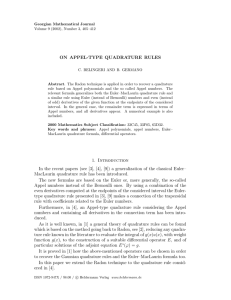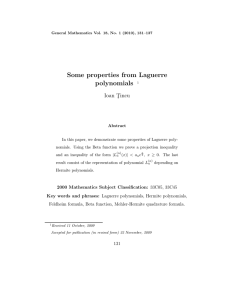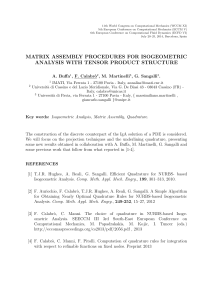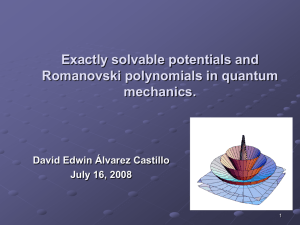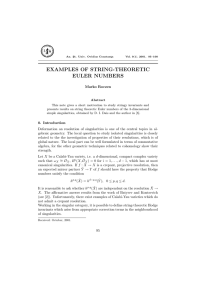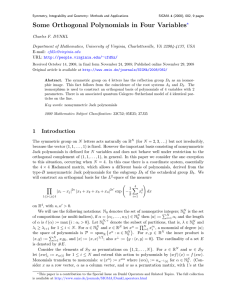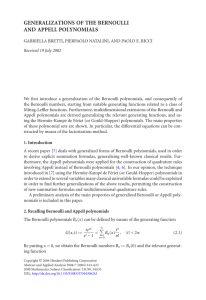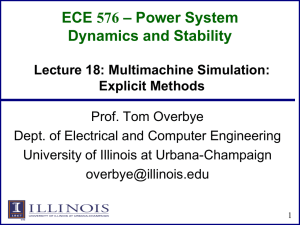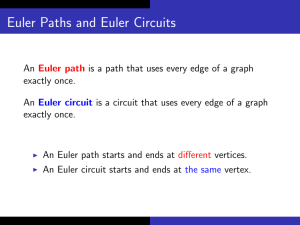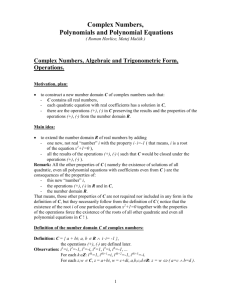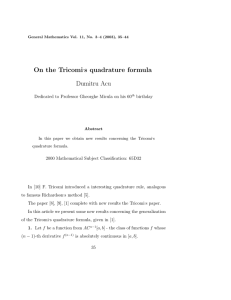EULER POLYNOMIALS AND THE RELATED QUADRATURE RULE
advertisement
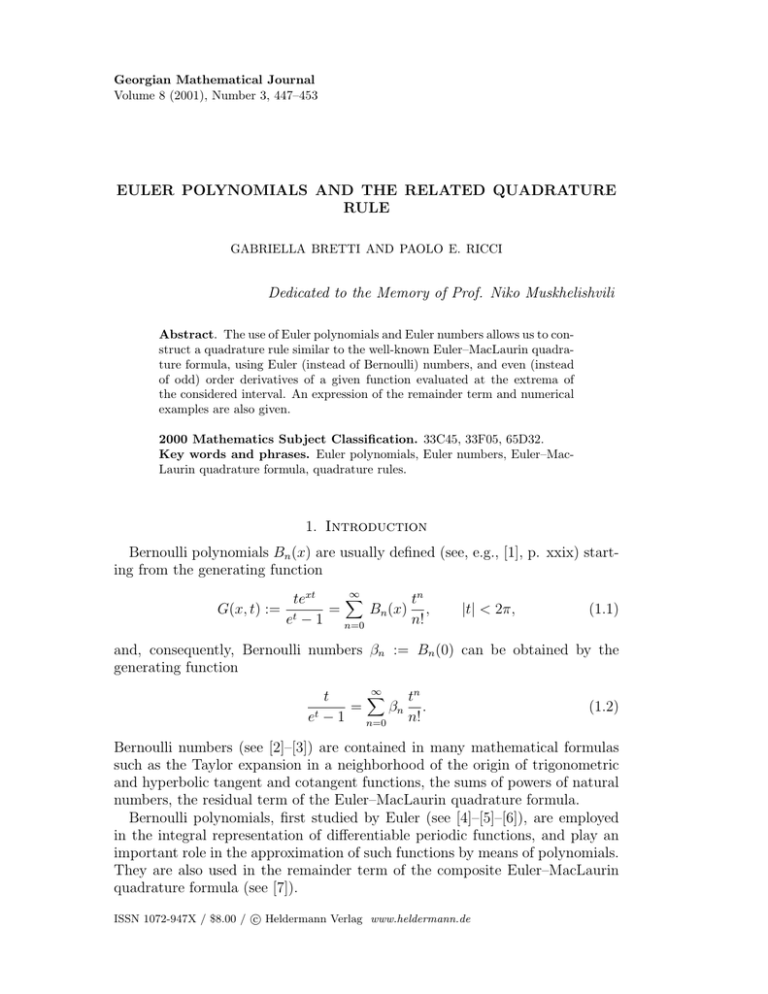
Georgian Mathematical Journal
Volume 8 (2001), Number 3, 447–453
EULER POLYNOMIALS AND THE RELATED QUADRATURE
RULE
GABRIELLA BRETTI AND PAOLO E. RICCI
Dedicated to the Memory of Prof. Niko Muskhelishvili
Abstract. The use of Euler polynomials and Euler numbers allows us to construct a quadrature rule similar to the well-known Euler–MacLaurin quadrature formula, using Euler (instead of Bernoulli) numbers, and even (instead
of odd) order derivatives of a given function evaluated at the extrema of
the considered interval. An expression of the remainder term and numerical
examples are also given.
2000 Mathematics Subject Classification. 33C45, 33F05, 65D32.
Key words and phrases. Euler polynomials, Euler numbers, Euler–MacLaurin quadrature formula, quadrature rules.
1. Introduction
Bernoulli polynomials Bn (x) are usually defined (see, e.g., [1], p. xxix) starting from the generating function
G(x, t) :=
∞
X
text
tn
=
,
B
(x)
n
et − 1 n=0
n!
|t| < 2π,
(1.1)
and, consequently, Bernoulli numbers βn := Bn (0) can be obtained by the
generating function
∞
X
t
tn
=
.
β
n
et − 1 n=0 n!
(1.2)
Bernoulli numbers (see [2]–[3]) are contained in many mathematical formulas
such as the Taylor expansion in a neighborhood of the origin of trigonometric
and hyperbolic tangent and cotangent functions, the sums of powers of natural
numbers, the residual term of the Euler–MacLaurin quadrature formula.
Bernoulli polynomials, first studied by Euler (see [4]–[5]–[6]), are employed
in the integral representation of differentiable periodic functions, and play an
important role in the approximation of such functions by means of polynomials.
They are also used in the remainder term of the composite Euler–MacLaurin
quadrature formula (see [7]).
c Heldermann Verlag www.heldermann.de
ISSN 1072-947X / $8.00 / °
448
GABRIELLA BRETTI AND PAOLO E. RICCI
Euler polynomials En (x) are defined by the generating function
∞
X
2ext
tn
=
E
(x)
,
n
et + 1 n=0
n!
|t| < π.
(1.3)
Euler numbers En can be obtained by the generating function
∞
X
2
En n
=
t ,
t
−t
e +e
n=0 n!
(1.4)
and the connection between Euler numbers and Euler polynomials is given by
µ ¶
1
= 2−n En ,
2
En
n = 0, 1, 2, . . . .
The first Euler numbers are given by
E0 = 1, E1 = 0, E2 = −1, E3 = 0, E4 = 5, E5 = 0, E6 = −61, E7 = 0, . . . .
For further values see [8], p. 810.
Euler polynomials are strictly connected with Bernoulli ones, and are used
in the Taylor expansion in a neighborhood of the origin of trigonometric and
hyperbolic secant functions.
Recursive computation of Bernoulli and Euler polynomials can be obtained
by using the following formulas:
n−1
X
k=0
à !
n
Bk (x) = nxn−1 ,
k
En (x) +
n
X
k=0
n = 2, 3, . . . ;
(1.5)
à !
n
Ek (x) = 2xn ,
k
n = 1, 2, . . . .
(1.6)
Further results can be found in a recent article by M. X. He and P. E. Ricci [9].
In this note, starting from the Euler polynomials, we construct a quadrature
rule similar to the well-known Euler–MacLaurin quadrature formula, using Euler (instead of Bernoulli) numbers in the remainder term, and even (instead
of odd) order derivatives of a given function evaluated at the extrema of the
considered interval.
In a forthcoming paper the same procedure will be applied in a more general
framework of Appell polynomials, including both the Euler–MacLaurin quadrature formula and the results of this article.
2. Definition and Simple Properties of Euler Polynomials
Euler polynomials En (t) can also be defined as polynomials of degree n ≥ 0
satisfying the conditions
0
(i) Em (t) = mEm−1 (t), m ≥ 1;
(ii) Em (t + 1) + Em (t) = 2tm , m ≥ 1.
EULER POLYNOMIALS AND THE RELATED QUADRATURE RULE
449
Note that a polynomial set Em (t) satisfying (i) and (ii) is such that
Em (t + 1) =
=
m
X
1
k=0 k!
Ã
m
X
m(m − 1) · · · (m − k + 1)Em−k (t)
!
Ã
!
m
m
X
X
m
m
Em−k (t) =
Es (t) =
Es (t),
s
k
s=0
s=0
k=0
and, consequently, from (ii), assuming m ≥ 1,
2tm = Em (t + 1) + Em (t) =
=
m−1
X
k=0
Ã
m
X
Ek (t) + Em (t)
k=0
!
m
Ek (t) + 2Em (t)
k
so that
Ã
!
X m
1 m−1
Em (t) = t −
Em (t),
2 k=0 k
m
m ≥ 1,
(2.1)
which is equivalent to (1.6).
Then Em (t) are determined if we know E0 (t) and E1 (t). The latter are
obtained by using the following procedure. Put E0 (t) = a and E1 (t) = at + b;
writing condition (ii), for m = 1, yields
2t = E1 (t + 1) + E1 (t) = a(t + 1) + b + at + b = 2at + a + 2b.
Now, equating the first and the last term in t, we find
a=1
and
b=−
1
2
and, consequently,
1
E1 (t) = t − .
(2.2)
2
The above considerations show that a polynomial set {Em (t)} satisfying (i) and
(ii), where Em (t) is of degree m ≥ 0, is uniquely determined by the recurrence
relation (2.1) with the initial conditions E0 (t) and E1 (t) given by (2.2). The
existence of such a set of polynomials is trivial since the set defined by (2.1)
and (2.2) satisfies conditions (i) and (ii).
Condition (i), for m = 2, gives
E0 (t) = 1
and
0
E2 (t) = 2E1 (t),
and, after integrating term by term,
E2 (t) = t2 − t,
and, for m = 3,
0
E3 (t) = 3E2 (t),
450
GABRIELLA BRETTI AND PAOLO E. RICCI
and, after integrating,
3
1
E3 (t) = t3 − t2 + ,
2
4
and so on.
Euler polynomials satisfy the symmetry relation
Em (1 − t) = (−1)m Em (t).
Since Em (0) = Em (1) = 0, for even m, we put, if m is odd:
em = Em (0) = −Em (1).
The connection of em with Euler numbers is given by the formula
Ã
!
m
1 X
m
em = − m
Em−h .
2 h=0 h
3. The Quadrature Formula
The main result of this paper is expressed by the following theorem.
Theorem 3.1. Consider a function f (x) ∈ C 2m [a, b] and the corresponding
integral over [a, b]. Let xi = a + ih, i = 0, 1, . . . , n, where h := b−a
, and
n
(p)
(p)
fi = f (xi ), fi = f (xi ), p = 1, 2, . . . , 2m. Then the following composite
trapezoidal rule holds true:
µ
Zb
f (x)dx = h
a
−
m−1
X
k=1
¶
1
1
f (a) + f1 + · · · + fn−1 + f (b)
2
2
h
i
e2k+1
h2k+1 f (2k) (b) + f (2k) (a) + RE [f ],
(2k + 1)!
(3.1)
where the correction terms are expressed by means of the even derivatives of the
given funcion f (x) at the extrema, and the error term is given by
xi+1
µ
¶
X Z
h2m n−1
x − xi
(2m)
RE [f ] =
f
(x)E2m
dx.
(2m)! i=0 x
h
(3.2)
i
Proof. We consider first the trapezoidal rule extended to the whole interval.
Put f (x) = f (a + ht) = g(t), where h := b − a denotes the length of a given
. By using successive integration by parts we find
interval, and t = x−a
h
Zb
Z1
f (x)dx = h
a
Z1
g(t)dt = h
0
= h [g(t)E1 (t)]10 −
g(t)dE1 (t)
0
Z1
0
g (t)E1 (t)dt
0
EULER POLYNOMIALS AND THE RELATED QUADRATURE RULE
1
451
1
i1
1h 0
1 Z 00
[g(1) + g(0)] − g (t)E2 (t) +
g (t)E2 (t)dt
=h
2
0
2
2
0
1
1
i1
1 h 00
1 Z 000
= h [g(1) + g(0)] − g (t)E3 (t) −
g (t)E3 (t)dt
0
2
6
6
0
½
i
i1
1
e3 h 00
1 h 000
00
=h
[g(1) + g(0)] −
g (1) + g (0) −
g (t)E4 (t)
0
2
6
24
1
1 Z (iv)
+
g (t)E4 (t)dt
24
0
½
i
i1
e3 h 00
1 h (iv)
1
00
=h
[g(1) + g(0)] −
g (1) + g (0) +
g (t)E5 (t)
0
2
6
120
1
1 Z (v)
g (t)E5 (t)dt = . . .
−
120
(
=h
0
m−1
i
X e2k+1 h
1
[g(1) + g(0)] −
g (2k) (1) + g (2k) (0)
2
k=1 (2k + 1)!
1
1 Z (2m)
+
g
(t)E2m (t)dt .
(2m)!
0
Recalling that f (x) = g(t), the preceding formula yields
(
Zb
f (x)dx = h
a
m−1
h
i
X e2k+1
1
[f (b) + f (a)] −
h2k f (2k) (b) + f (2k) (a)
2
k=1 (2k + 1)!
b
¶
µ
h2m−1 Z (2m)
x−a
+
f
(x)E2m
dx .
(2m)! a
h
(3.3)
Consider now the partition of the interval [a, b] into n partial intervals by means
of equidistant knots xi = a + ih, i = 0, 1, . . . , n, where h := b−a
, fi = f (xi ),
n
(p)
fi = f (p) (xi ), p = 1, 2, . . . , 2m. By (3.3) we have
Zb
f (x)dx =
a
n−1
X
xZi+1
i=0 xi
−
m−1
X
k=1
µ
¶
1
1
f (x)dx = h f (a) + f1 + · · · + fn−1 + f (b)
2
2
h
i
e2k+1
h2k+1 f (2k) (b) + f (2k) (a)
(2k + 1)!
xi+1
¶
µ
X Z
h2m n−1
x − xi
+
dx.
f (2m) (x)E2m
(2m)! i=0 x
h
i
452
GABRIELLA BRETTI AND PAOLO E. RICCI
Note that the remainder term of the above procedure is expressed by
xi+1
µ
¶
X Z
h2m n−1
x − xi
(2m)
RE [f ] =
f
(x)E2m
dx.
(2m)! i=0 x
h
i
Remark 3.1. The above quadrature rule is similar to the well known Euler–
MacLaurin quadrature formula, but the correction terms of the trapezoidal
rule are expressed by the even (instead of odd) derivatives of the function f
computed at the extrema of the interval [a, b], and it makes use of Euler (instead
of Bernoulli) numbers.
By using equations (3.1)–(3.3), it is possible to write explicitly summation
formulas for values of an analytic function (in particular of a polynomial) on
equidistant knots similar to those which appear in [10], pp. 158–159, formulas
(5.8.11)–(5.8.15).
4. Numerical Examples
We consider here two simple examples of the application of formula (3.1).
Consider the elementary integral
Z1
I :=
0
1
dx = ln 2 ' 0.69314718 . . . .
1+x
By using (3.1) with n = 90 and m = 6 we have found numerical approximation
I ' 0.69315476 . . .
so that an absolute error is less than 10−5 , and a relative error is less than
2 × 10−5 .
Consider now the integral
J :=
Z2 x
e
1
x
dx ' 3.0591166 . . . .
By using (3.1) with n = 90 and m = 7 we have found numerical approximation
J ' 3.0591352 . . .
so that an absolute error is less than 2 × 10−5 , and a relative error is less than
10−5 .
Acknowledgement
This paper was prepared (concluded) in the framework of the Italian National
Group for Scientific Computation (G.N.C.S.) whose partial support we wish to
acknowledge.
EULER POLYNOMIALS AND THE RELATED QUADRATURE RULE
453
References
1. I. S. Gradshteyn and I. M. Ryzhik, Table of integrals, series, and products. (Translated from Russian) Academic Press, New York etc., 1980.
2. J. Bernoulli, Ars conjectandi. Basel, 1713.
3. L. Saalschuetz, Vorlesungen über dir Bernoullischen Zahlen. Berlin, 1893.
4. L. Euler, Instituziones calculi differentialis. Opera Omnia, Series prima: opera mathematica 10, Teubner, 1980.
5. N. E. Nörlund, Vorlesungen über Differenzenrechnung. Berlin, 1924.
6. H. Bateman and A. Erdélyi, Higher trascendental functions. The Gamma function.
The hypergeometric function. Legendre functions. Vol. 1. McGraw-Hill, 1953.
7. J. Stoer, Introduzione all’Analisi Numerica. Zanichelli, Bologna, 1972.
8. M. Abramowitz and I. A. Stegun, Handbook of mathematical functions. Dover, New
York, 1965.
9. M. X. He and P. E. Ricci, Differential equation of Bernoulli polynomials via the factorization method. J. Comput. Appl. Math. (accepted, in print).
10. F. B. Hildebrand, Analisi numerica. Ambrosiana, Milano, 1967.
(Received 10.03.2001)
Authors’ address:
Dipartimento di Matematica “Guido CASTELNUOVO”
Università degli Studi di Roma “La Sapienza”
P.le A. Moro, 2 – 00185 Roma
Italia
E-mail: bretti@mat.uniroma1.it
riccip@uniroma1.it
